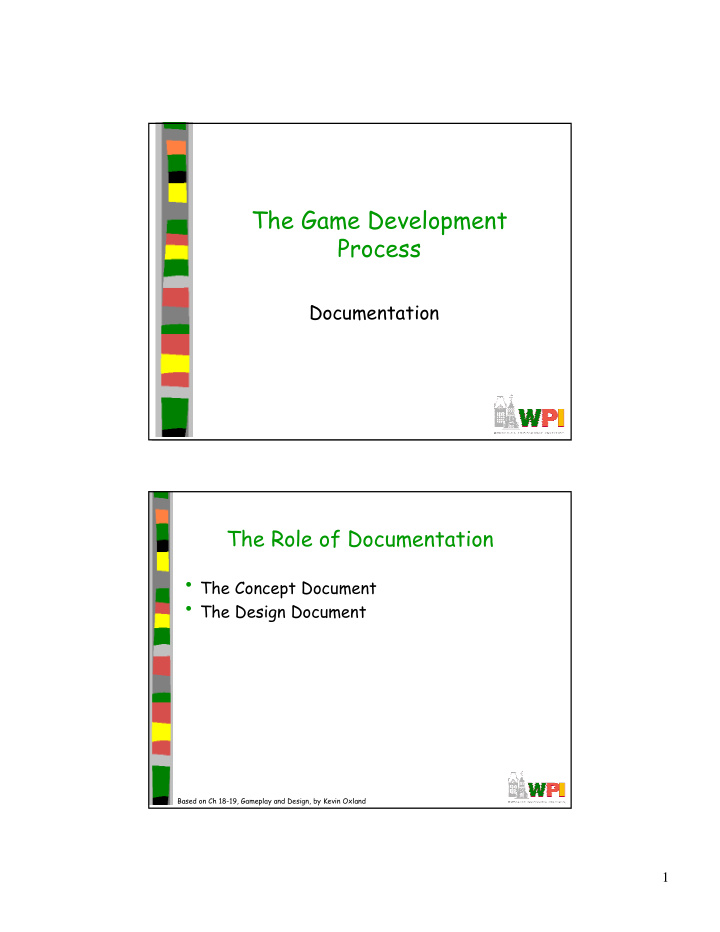



The Game Development Process Documentation The Role of Documentation • The Concept Document • The Design Document Based on Ch 18-19, Gameplay and Design, by Kevin Oxland 1
The Concept Document - Overview • Use to sell idea – To investors, externally – To colleagues, internally • First document people will read (many, only document they will read) • Always have a concept document – Maybe exception for sequel – Maybe exception for development team of 1 • Reflects abbreviated version of the game • Should be able to “play” game in “minds eye” – Reader will bring preconceived notions, so be clear about what is innovative and different Based on Ch 18-19, Gameplay and Design, by Kevin Oxland The Concept Document - Overview • No “correct” way, but certain common elements • Can include artists inspiration if involved in the early design (“Picture worth a thousand words”) – Rough sketches of characters/environment • Title page – Title, author, one-sentence description – Example: “Norbot, Quest for Freedom” Based on Ch 18-19, Gameplay and Design, by Kevin Oxland 2
The Concept Document - Intro • Genre. – Example: action-adventure, 3 rd person • Platform (maybe justify, maybe include 2 nd -ary platform) – Example: All Game Consoles – If PC, provide specifications • Target audience (demographics) • Market research – Indicate potential of game – Should justify target audience, genre, platform – Example: action-adventure best selling, but repetitive, so includes new themes. Family friendly so weapons are defensive … Based on Ch 18-19, Gameplay and Design, by Kevin Oxland The Concept Document – Expand Idea • Overview – high level, 1-2 paragraphs – Example: 3 rd person action adventure in fantasy setting, with puzzle solving and narrative… • Core objectives – player goal – Example: Guide Norbot to safety – Example: Use robot attachments, get parts (hand, heart, soul) … stimulate player • Game play theme – conceptual premise – Example: Robots, both bad and good, with switchable components Based on Ch 18-19, Gameplay and Design, by Kevin Oxland 3
The Concept Document - Expand Idea • Game structure – how game proceeds – Example: Several major worlds, sub-quests – Example: Expand capabilities of Norbot • Distinctive features – what sets game apart – Example: Unique character, customizable robot – Example: Unique sub-worlds and puzzles • Character features – what the player avatar (if appropriate) will do – Example: Movmement, visual aids, weapons, maps, inventory Based on Ch 18-19, Gameplay and Design, by Kevin Oxland The Concept Document - Environment • Game world, description – includes look and feel – Example: modern robot city, recycling plant • Features that provide the game flavor Based on Ch 18-19, Gameplay and Design, by Kevin Oxland 4
The Concept Document – Player Mechanics • Internal rules for how player will interact with world (example of Norbot below) – Character internals (hit points, stamina) – Rewards (powerups) – Environment interactions (pickup, drop items) – Maps (saving and loading) – Camera views – Control Mechanisms (interface with keys or console) Based on Ch 18-19, Gameplay and Design, by Kevin Oxland The Concept Document - Artifacts • Includes weapons, treasure, etc. • Details on use, general rule interaction • Friends and foes – Not details, but general appearance and roles – Include main enemy Based on Ch 18-19, Gameplay and Design, by Kevin Oxland 5
The Concept Document - Story • May be last if story is not important to game • But sometimes story will interest audience (and publisher) more • Game industry sucks at stories – IMGD 1002. Storytelling in Interactive Media and Games Based on Ch 18-19, Gameplay and Design, by Kevin Oxland The Concept Document – Timeline and Misc • Timeline for development completion – May include budget • Misc – anything else that should be said about the concept of the game – mocked-up screenshots, concept sketches, sample level designs, backstory, character descriptions, game balance discussions, and etc. Based on Ch 18-19, Gameplay and Design, by Kevin Oxland 6
The Concept Document – What Next? • Will undergo several drafts before v1.0 (ready to show publisher) • Feedback – Development team (art, technical, producer) – Incorporate comments when appropriate • Not all feedback is appropriate • Pitch – An art, so not always the designer (marketer?) – Storyboards, artwork, other props • Give your game a physical presence Based on Ch 18-19, Gameplay and Design, by Kevin Oxland The Design Document • How to build your game – Written for development team – May take 4-6 months to complete • Analogy: building a house – Architect plans building – sketches, blueprints, boundaries layout – May include miniature model – Contact authorities, permits materials – Then, finally , build – Should be the same for Game Development! Based on Ch 18-19, Gameplay and Design, by Kevin Oxland 7
The Design Document • Should describe game in detail – Innermost working to outermost visual feedback • One early component is “The Gameplay Spec” – Highly detailed description of the game – Given to programmers • Also keep “Designers Notes” – Ideas related to details in the spec – Analogous to comments in programming code … explains the “why” behind the “what” in the spec • Not everyone will read every part • How long? Long enough. 200-300 pages. • More details if time Based on Ch 18-19, Gameplay and Design, by Kevin Oxland 8
Recommend
More recommend